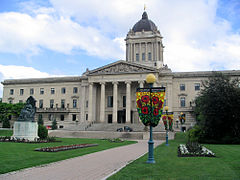Manitoba Legislative Building
| Manitoba Legislative Building | |
|---|---|
 |
|
| General information | |
| Architectural style | Neoclassical |
| Address | 450 Broadway Winnipeg, Manitoba R3C 0V8 |
| Town or city | Winnipeg, Manitoba |
| Country | Canada |
| Construction started | 1913 |
| Cost | CDN$ 8,075,865 (1921 est.) |
| Height | 242 feet (74 m) |
| Technical details | |
| Floor area | 250,000 ft2 |
| Design and construction | |
| Architect | Frank Worthington Simon & Henry Boddington III |
The Manitoba Legislative Building is the meeting place of the Legislative Assembly of Manitoba, in central Winnipeg. It was originally named the Manitoba Parliament Building, not Legislative. The neoclassical building was completed in 1920 and stands seventy-seven metres tall (253 ft). It was designed and built by Frank Worthington Simon (1862–1933) and Henry Boddington III, along with other masons and many skilled craftsmen. The building is famous for the Golden Boy, a gold covered bronze statue based on the style of the Roman god Mercury, or the Greek god Hermes, at the top of the cupola, or domed ceiling.
The Manitoba Legislative Building is open every day of the year (including Saturdays and Sundays) for self-guided tours, and guided tours are available.
In 1911, the Manitoba government announced an architectural competition to all architects in the British Empire. A grand prize of $10,000 was offered for the best design for the new Manitoba Legislative Building. It is the third building used by Manitoba's legislative assembly, the first being the home of A.G.B. Bannatyne, while the second stood on the same grounds as the current Legislative building. Of the 67 submissions, Frank Worthington Simon, a former student at the École des Beaux-Arts, had his design chosen for the construction of the impressive structure.
Construction began in 1913, with Tyndall stone, quarried at Garson, about 20 kilometres northeast of Winnipeg. On June 3, 1914 the north-east cornerstone ceremony, which was commonly done by masons, was laid by Thomas Kelly, the contractor. Kelly stole many of the materials to build his own house three blocks away, so the construction of the massive building was slowed and was not ready for partial occupancy until 1919. On July 15, 1920, the province's 50th anniversary date, opening ceremonies were performed by Sir James Aikins, then Lieutenant-Governor of Manitoba.
...
Wikipedia
